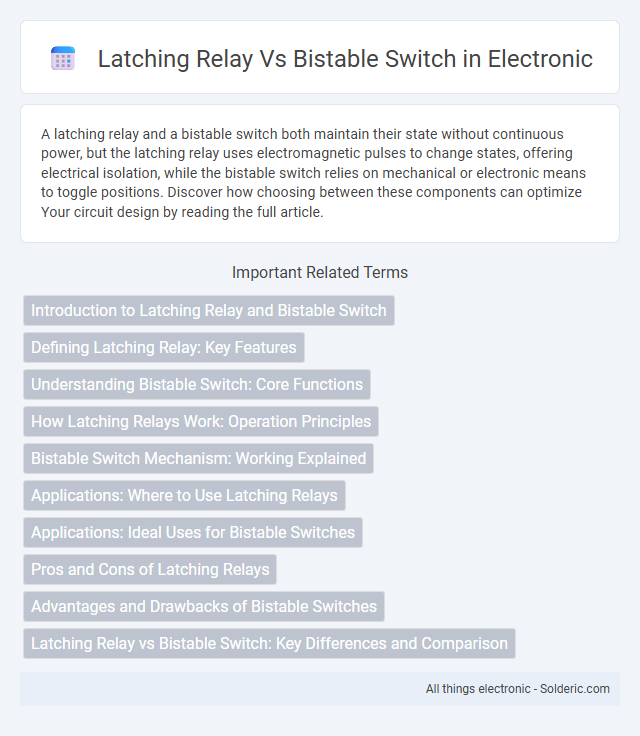A latching relay and a bistable switch both maintain their state without continuous power, but the latching relay uses electromagnetic pulses to change states, offering electrical isolation, while the bistable switch relies on mechanical or electronic means to toggle positions. Discover how choosing between these components can optimize Your circuit design by reading the full article.
Comparison Table
| Feature | Latching Relay | Bistable Switch |
|---|---|---|
| Definition | Electromechanical relay maintaining contacts position without power | Mechanical or electronic switch with two stable states toggled by input signals |
| Power Consumption | Power needed only during switching | No continuous power required to hold state |
| Switching Mechanism | Coil pulse to change state; magnetic latch holds position | Toggle action via mechanical or electronic means |
| Durability | High mechanical lifecycle (~10^6+ operations) | Depends on type; mechanical: ~10^5 ops, electronic: higher |
| Applications | Power circuits, motor controls, memory circuits | User interfaces, signal toggling, low-power switching |
| Response Time | Slower than solid-state, milliseconds range | Faster response, especially electronic bistable switches |
| Size | Bulkier due to coil and magnetic components | Compact; varies by design |
Introduction to Latching Relay and Bistable Switch
Latching relays and bistable switches are electrical components designed to maintain their position without continuous power, making them energy-efficient solutions for switching circuits. Latching relays use electromagnetic coils to toggle between states, retaining their last position via a magnetic latch, which ensures stable operation in memory and control applications. Bistable switches operate by mechanical or magnetic means to switch between two stable states, providing reliable manual or automatic control in various electrical systems.
Defining Latching Relay: Key Features
A latching relay is an electromechanical switch that maintains its position after being actuated, requiring power only during state changes, which enhances energy efficiency. Designed with two stable states, it uses a magnetic latch to hold the contact position without continuous input, making it ideal for applications needing reliable, low-power control. Your system benefits from this device by reducing energy consumption and ensuring consistent operation in automation and control scenarios.
Understanding Bistable Switch: Core Functions
A bistable switch maintains its state without continuous power, offering reliable memory retention for circuits by toggling between two stable positions. Unlike a latching relay, which uses electromagnetic coils to switch and hold its state mechanically, the bistable switch operates electronically, providing faster switching and lower energy consumption. Understanding these core functions enables you to choose the best component for efficient, low-power circuit designs.
How Latching Relays Work: Operation Principles
Latching relays operate by maintaining their contact position after activation, using a magnetic or mechanical latch, which allows them to consume power only during switching instead of continuously. They have two stable states and rely on a brief pulse of current to change states, making them highly energy-efficient and ideal for low-power applications. Your system benefits from this design by ensuring reliable operation with reduced energy consumption compared to bistable switches, which require consistent power to maintain their states.
Bistable Switch Mechanism: Working Explained
The bistable switch mechanism operates by maintaining its position in either an ON or OFF state without continuous power, using a magnetic or mechanical latch to hold the contact position. It changes states only when an external pulse or trigger is applied, resulting in low energy consumption and reliable operation in control circuits. Unlike latching relays, bistable switches do not require coil energization to maintain state, enhancing efficiency in battery-powered or energy-sensitive applications.
Applications: Where to Use Latching Relays
Latching relays are ideal for applications requiring energy-efficient, non-volatile switching such as smart home automation, HVAC systems, and industrial control panels where maintaining state without continuous power is crucial. They excel in battery-powered devices, remote controls, and lighting circuits, ensuring your system retains its position after power loss. Unlike bistable switches, latching relays reduce power consumption and improve reliability in scenarios demanding persistent state retention.
Applications: Ideal Uses for Bistable Switches
Bistable switches are ideal for applications requiring reliable, low-power state retention without continuous energy consumption, such as in lighting controls, smart home systems, and memory storage devices. Their ability to maintain position after actuation makes them perfect for use in remote or battery-powered devices where energy efficiency is critical. Your choice of a bistable switch ensures stable operation in environments demanding minimal power usage and durable switching performance.
Pros and Cons of Latching Relays
Latching relays offer significant power efficiency by maintaining their position without continuous power, ideal for low-energy applications. They provide reliable mechanical switching and can handle higher current loads compared to bistable switches, but their mechanical components may wear out over time, reducing longevity. Despite slower switching speeds and increased physical size, latching relays excel in applications requiring stable state retention and energy savings.
Advantages and Drawbacks of Bistable Switches
Bistable switches offer the advantage of maintaining their position without continuous power, which significantly reduces energy consumption and heat generation in your electrical system. They provide reliable operation in memory-critical applications since their state is retained even during power interruptions. However, bistable switches can have slower response times and increased mechanical complexity compared to conventional latching relays, potentially affecting their durability and cost-effectiveness in high-frequency switching environments.
Latching Relay vs Bistable Switch: Key Differences and Comparison
Latching relays and bistable switches both maintain their state without continuous power but differ in operation and design. Latching relays use electromagnetic coils to change and hold contacts, enabling precise control in automation and low-power applications. Bistable switches rely on mechanical or electronic toggling mechanisms, often found in user interfaces and simple switching tasks, offering simpler construction but less electrical isolation than latching relays.
latching relay vs bistable switch Infographic

 solderic.com
solderic.com